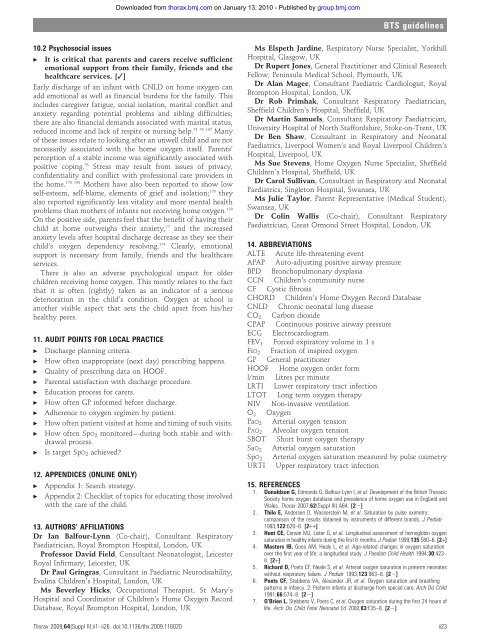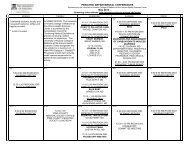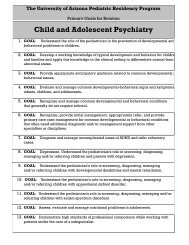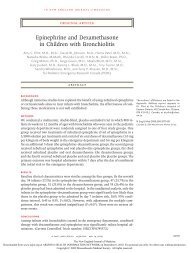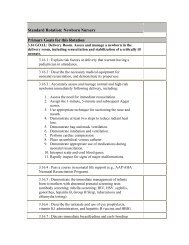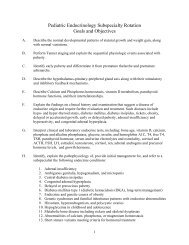BTS guidelines for home oxygen in children - University of Arizona ...
BTS guidelines for home oxygen in children - University of Arizona ...
BTS guidelines for home oxygen in children - University of Arizona ...
You also want an ePaper? Increase the reach of your titles
YUMPU automatically turns print PDFs into web optimized ePapers that Google loves.
Downloaded from thorax.bmj.com on January 13, 2010 - Published by group.bmj.com<br />
<strong>BTS</strong> <strong>guidel<strong>in</strong>es</strong><br />
10.2 Psychosocial issues<br />
c<br />
It is critical that parents and carers receive sufficient<br />
emotional support from their family, friends and the<br />
healthcare services. [3]<br />
Early discharge <strong>of</strong> an <strong>in</strong>fant with CNLD on <strong>home</strong> <strong>oxygen</strong> can<br />
add emotional as well as f<strong>in</strong>ancial burdens <strong>for</strong> the family. This<br />
<strong>in</strong>cludes caregiver fatigue, social isolation, marital conflict and<br />
anxiety regard<strong>in</strong>g potential problems and sibl<strong>in</strong>g difficulties;<br />
there are also f<strong>in</strong>ancial demands associated with marital status,<br />
reduced <strong>in</strong>come and lack <strong>of</strong> respite or nurs<strong>in</strong>g help. 74 76 197 Many<br />
<strong>of</strong> these issues relate to look<strong>in</strong>g after an unwell child and are not<br />
necessarily associated with the <strong>home</strong> <strong>oxygen</strong> itself. Parents’<br />
perception <strong>of</strong> a stable <strong>in</strong>come was significantly associated with<br />
positive cop<strong>in</strong>g. 76 Stress may result from issues <strong>of</strong> privacy,<br />
confidentiality and conflict with pr<strong>of</strong>essional care providers <strong>in</strong><br />
the <strong>home</strong>. 170 198 Mothers have also been reported to show low<br />
self-esteem, self-blame, elements <strong>of</strong> grief and isolation; 170 they<br />
also reported significantly less vitality and more mental health<br />
problems than mothers <strong>of</strong> <strong>in</strong>fants not receiv<strong>in</strong>g <strong>home</strong> <strong>oxygen</strong>. 199<br />
On the positive side, parents feel that the benefit <strong>of</strong> hav<strong>in</strong>g their<br />
child at <strong>home</strong> outweighs their anxiety, 77 and the <strong>in</strong>creased<br />
anxiety levels after hospital discharge decrease as they see their<br />
child’s <strong>oxygen</strong> dependency resolv<strong>in</strong>g. 174 Clearly, emotional<br />
support is necessary from family, friends and the healthcare<br />
services.<br />
There is also an adverse psychological impact <strong>for</strong> older<br />
<strong>children</strong> receiv<strong>in</strong>g <strong>home</strong> <strong>oxygen</strong>. This mostly relates to the fact<br />
that it is <strong>of</strong>ten (rightly) taken as an <strong>in</strong>dicator <strong>of</strong> a serious<br />
deterioration <strong>in</strong> the child’s condition. Oxygen at school is<br />
another visible aspect that sets the child apart from his/her<br />
healthy peers.<br />
11. AUDIT POINTS FOR LOCAL PRACTICE<br />
c<br />
c<br />
c<br />
c<br />
c<br />
c<br />
c<br />
c<br />
c<br />
c<br />
Discharge plann<strong>in</strong>g criteria.<br />
How <strong>of</strong>ten <strong>in</strong>appropriate (next day) prescrib<strong>in</strong>g happens.<br />
Quality <strong>of</strong> prescrib<strong>in</strong>g data on HOOF.<br />
Parental satisfaction with discharge procedure.<br />
Education process <strong>for</strong> carers.<br />
How <strong>of</strong>ten GP <strong>in</strong><strong>for</strong>med be<strong>for</strong>e discharge.<br />
Adherence to <strong>oxygen</strong> regimen by patient.<br />
How <strong>of</strong>ten patient visited at <strong>home</strong> and tim<strong>in</strong>g <strong>of</strong> such visits.<br />
How <strong>of</strong>ten SpO 2 monitored—dur<strong>in</strong>g both stable and withdrawal<br />
process.<br />
Is target SpO 2 achieved?<br />
12. APPENDICES (ONLINE ONLY)<br />
c<br />
c<br />
Appendix 1: Search strategy.<br />
Appendix 2: Checklist <strong>of</strong> topics <strong>for</strong> educat<strong>in</strong>g those <strong>in</strong>volved<br />
with the care <strong>of</strong> the child.<br />
13. AUTHORS’ AFFILIATIONS<br />
Dr Ian Balfour-Lynn (Co-chair), Consultant Respiratory<br />
Paediatrician, Royal Brompton Hospital, London, UK<br />
Pr<strong>of</strong>essor David Field, Consultant Neonatologist, Leicester<br />
Royal Infirmary, Leicester, UK<br />
Dr Paul Gr<strong>in</strong>gras, Consultant <strong>in</strong> Paediatric Neurodisability,<br />
Eval<strong>in</strong>a Children’s Hospital, London, UK<br />
Ms Beverley Hicks, Occupational Therapist, St Mary’s<br />
Hospital and Coord<strong>in</strong>ator <strong>of</strong> Children’s Home Oxygen Record<br />
Database, Royal Brompton Hospital, London, UK<br />
Thorax 2009;64(Suppl II):ii1–ii26. doi:10.1136/thx.2009.116020<br />
Ms Elspeth Jard<strong>in</strong>e, Respiratory Nurse Specialist, Yorkhill<br />
Hospital, Glasgow, UK<br />
Dr Rupert Jones, General Practitioner and Cl<strong>in</strong>ical Research<br />
Fellow, Pen<strong>in</strong>sula Medical School, Plymouth, UK<br />
Dr Alan Magee, Consultant Paediatric Cardiologist, Royal<br />
Brompton Hospital, London, UK<br />
Dr Rob Primhak, Consultant Respiratory Paediatrician,<br />
Sheffield Children’s Hospital, Sheffield, UK<br />
Dr Mart<strong>in</strong> Samuels, Consultant Respiratory Paediatrician,<br />
<strong>University</strong> Hospital <strong>of</strong> North Staf<strong>for</strong>dshire, Stoke-on-Trent, UK<br />
Dr Ben Shaw, Consultant <strong>in</strong> Respiratory and Neonatal<br />
Paediatrics, Liverpool Women’s and Royal Liverpool Children’s<br />
Hospital, Liverpool, UK<br />
Ms Sue Stevens, Home Oxygen Nurse Specialist, Sheffield<br />
Children’s Hospital, Sheffield, UK<br />
Dr Carol Sullivan, Consultant <strong>in</strong> Respiratory and Neonatal<br />
Paediatrics, S<strong>in</strong>gleton Hospital, Swansea, UK<br />
Ms Julie Taylor, Parent Representative (Medical Student),<br />
Swansea, UK<br />
Dr Col<strong>in</strong> Wallis (Co-chair), Consultant Respiratory<br />
Paediatrician, Great Ormond Street Hospital, London, UK<br />
14. ABBREVIATIONS<br />
ALTE Acute life-threaten<strong>in</strong>g event<br />
APAP Auto-adjust<strong>in</strong>g positive airway pressure<br />
BPD Bronchopulmonary dysplasia<br />
CCN Children’s community nurse<br />
CF Cystic fibrosis<br />
CHORD Children’s Home Oxygen Record Database<br />
CNLD Chronic neonatal lung disease<br />
CO 2 Carbon dioxide<br />
CPAP Cont<strong>in</strong>uous positive airway pressure<br />
ECG Electrocardiogram<br />
FEV 1 Forced expiratory volume <strong>in</strong> 1 s<br />
FiO 2 Fraction <strong>of</strong> <strong>in</strong>spired <strong>oxygen</strong><br />
GP General practitioner<br />
HOOF Home <strong>oxygen</strong> order <strong>for</strong>m<br />
l/m<strong>in</strong> Litres per m<strong>in</strong>ute<br />
LRTI Lower respiratory tract <strong>in</strong>fection<br />
LTOT Long term <strong>oxygen</strong> therapy<br />
NIV Non-<strong>in</strong>vasive ventilation<br />
O 2 Oxygen<br />
PaO 2 Arterial <strong>oxygen</strong> tension<br />
PAO 2 Alveolar <strong>oxygen</strong> tension<br />
SBOT Short burst <strong>oxygen</strong> therapy<br />
SaO 2 Arterial <strong>oxygen</strong> saturation<br />
SpO 2 Arterial <strong>oxygen</strong> saturation measured by pulse oximetry<br />
URTI Upper respiratory tract <strong>in</strong>fection<br />
15. REFERENCES<br />
1. Donaldson G, Edmonds G, Balfour-Lynn I, et al. Development <strong>of</strong> the British Thoracic<br />
Society <strong>home</strong> <strong>oxygen</strong> database and prevalence <strong>of</strong> <strong>home</strong> <strong>oxygen</strong> use <strong>in</strong> England and<br />
Wales. Thorax 2007;62(Suppl III):A64. [22]<br />
2. Thilo E, Andersen D, Wasserste<strong>in</strong> M, et al. Saturation by pulse oximetry:<br />
comparison <strong>of</strong> the results obta<strong>in</strong>ed by <strong>in</strong>struments <strong>of</strong> different brands. J Pediatr<br />
1993;122:620–6. [2++]<br />
3. Hunt CE, Corw<strong>in</strong> MJ, Lister G, et al. Longitud<strong>in</strong>al assessment <strong>of</strong> hemoglob<strong>in</strong> <strong>oxygen</strong><br />
saturation <strong>in</strong> healthy <strong>in</strong>fants dur<strong>in</strong>g the first 6 months. JPediatr1999;135:580–6. [2+]<br />
4. Masters IB, Goes AM, Healy L, et al. Age-related changes <strong>in</strong> <strong>oxygen</strong> saturation<br />
over the first year <strong>of</strong> life: a longitud<strong>in</strong>al study. J Paediatr Child Health 1994;30:423–<br />
8. [2+]<br />
5. Richard D, Poets CF, Neale S, et al. Arterial <strong>oxygen</strong> saturation <strong>in</strong> preterm neonates<br />
without respiratory failure. J Pediatr 1993;123:963–8. [22]<br />
6. Poets CF, Stebbens VA, Alexander JR, et al. Oxygen saturation and breath<strong>in</strong>g<br />
patterns <strong>in</strong> <strong>in</strong>fancy. 2: Preterm <strong>in</strong>fants at discharge from special care. Arch Dis Child<br />
1991;66:574–8. [22]<br />
7. O’Brien L, Stebbens V, Poets C, et al. Oxygen saturation dur<strong>in</strong>g the first 24 hours <strong>of</strong><br />
life. Arch Dis Child Fetal Neonatal Ed 2000;83:F35–8. [22]<br />
ii23


